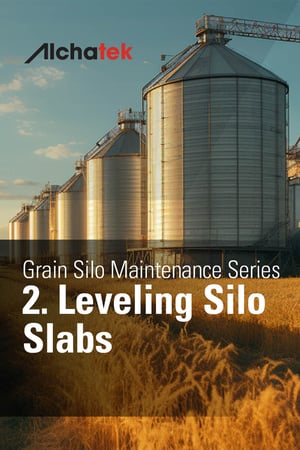
 In the world of grain storage, the focus often falls on the towering structures that dominate the landscape. However, what lies beneath these silos—the concrete slabs—plays an equally critical role in ensuring the safety and efficiency of grain storage operations. Sunken slabs can compromise the structural integrity of the entire silo, posing safety risks and operational challenges. Here, the importance of maintaining stable and level slabs, the role they play in structural integrity, and the use of polyurethane for slab leveling are explored.
In the world of grain storage, the focus often falls on the towering structures that dominate the landscape. However, what lies beneath these silos—the concrete slabs—plays an equally critical role in ensuring the safety and efficiency of grain storage operations. Sunken slabs can compromise the structural integrity of the entire silo, posing safety risks and operational challenges. Here, the importance of maintaining stable and level slabs, the role they play in structural integrity, and the use of polyurethane for slab leveling are explored.
The Role of Slabs in Structural Integrity
Structural Importance of Slabs
Concrete slabs serve as the foundation for grain silos. They bear the weight of the structure and its contents, distributing the load evenly to the ground below. When these slabs become unstable, they can cause uneven weight distribution, leading to undue stress on specific parts of the silo. Over time, this stress can manifest as cracks in the walls, deformations in the structure, or, in extreme cases, partial collapse.
Safety Concerns
An unstable slab isn't just an engineering problem; it's a safety hazard. The risk of structural failure poses a direct threat to anyone working in or around the silo. In addition, unstable slabs can make it difficult to operate machinery efficiently, leading to further safety risks. For example, forklifts or other heavy equipment may struggle to navigate an uneven surface, increasing the likelihood of accidents.
Polyurethane for Slab Leveling
Structural Polyurethane Foam
When it comes to leveling slabs, polyurethane offers several advantages over traditional methods like mudjacking or concrete replacement. One of the most significant benefits is the speed of application. Polyurethane foam can be injected directly into the affected areas, expanding to fill gaps and level the slab. This process can often be completed in a matter of hours, minimizing operational downtime.
Another advantage is the material's lightweight nature. Unlike concrete, polyurethane doesn't add significant weight to the slab, reducing the risk of overloading the soil beneath. Its flexibility also allows for some movement, accommodating natural soil shifts without compromising the integrity of the repair.
Hire an Experienced Contractor
While polyurethane offers an effective leveling solution, proper installation is key to achieving optimal, long-lasting results. Look for a contractor who specializes in slab lifting and has expertise specifically with structural polyurethane foam. They will understand the intricacies of assessing the degree of settlement, calculating the void space, and injecting the precise amount of polyurethane foam needed. An experienced contractor will also follow best practices for drilling injection holes and sealing them after use.
Rushing through the job or cutting corners on materials and techniques can lead to subpar leveling results. While it may cost more upfront, hiring an experienced contractor is well worth the investment in the long run through superior results and minimized repeat repairs. Their expertise delivers slab leveling done right the first time.
Key Takeaways
The stability of the slabs beneath grain silos is a critical but often overlooked aspect of silo management. These slabs play a vital role in maintaining the structural integrity of the silo and ensuring the safety of workers. Unstable slabs can lead to a host of problems, from structural damage to operational inefficiencies.
Polyurethane offers a quick and effective solution for leveling slabs, with advantages such as rapid application and reduced weight. By taking a proactive approach to slab maintenance and repair, silo owners and operators can mitigate risks, improve operational efficiency, and safeguard both their investment and the people who depend on it.
Addressing unstable slabs is not merely a maintenance task but a strategic action that impacts the overall safety and efficiency of grain storage operations. By understanding the role of slabs in structural integrity, the advantages and disadvantages of using polyurethane, and the importance of regulatory compliance, actionable steps can be taken to ensure the long-term success and safety of grain silo operations.



